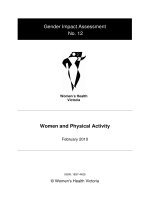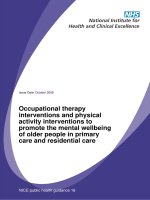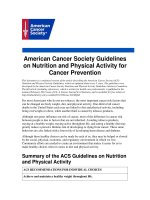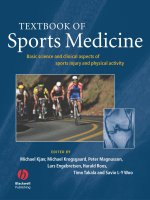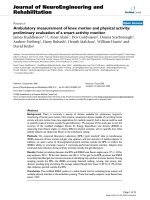Anthropometry and body composition of indonesian adults an evaluation of body image, eating behaviours, and physical activity
Bạn đang xem bản rút gọn của tài liệu. Xem và tải ngay bản đầy đủ của tài liệu tại đây (4.06 MB, 356 trang )
ANTHROPOMETRY AND BODY COMPOSITION OF
INDONESIAN ADULTS: AN EVALUATION OF BODY
IMAGE, EATING BEHAVIOURS, AND PHYSICAL
ACTIVITY
Janatin Hastuti, S.Si., M.Kes.
Submitted in fulfilment of the requirements for the degree of
Doctor of Philosophy
School of Exercise and Nutrition Sciences
Faculty of Health
Queensland University of Technology
2013
i
ii
KEYWORDS
Anthropometry; body composition; deuterium isotope dilution; bioelectrical
impedance analysis; percent body fat; body image; eating behaviours; physical activity;
Indonesian adults
i
ABSTRACT
Obesity has been identified as a global epidemic and is associated with significant
morbidity and mortality. Body Mass Index (BMI) is commonly used to determine
overweight and obesity in epidemiological studies, however, BMI cannot
differentiate the fat and lean mass in body composition and an increasing number
of studies are reporting that the relationship between BMI and %BF is different
among different populations (Deurenberg, Deurenberg-Yap & Guricci, 2002;
Deurenberg, Yap & van Staveren, 1998). Moreover, assessment of body
composition is a better approach in the evaluation of nutritional and health status.
Some anthropometric measures and indices such as waist circumference (WC),
waist-to-stature ratio (WSR), and waist-to-hip ratio (WHR) are also suggested as
better indicators of obesity compared with BMI. However, assessments of
anthropometry and body composition and their associated benefits in Indonesian
adults are very limited. This may be partly due to the limited field-based methods
available to assess body composition in this population. Many studies have reported
the usefulness of prediction equations from anthropometric measures and
bioelectrical impedance analysis (BIA) to provide detailed assessment of body
composition. However, no data has been reported for Indonesian populations. The
present study provides knowledge of anthropometry and body composition in
Indonesian adults and some associated factors including body image, eating
behaviours, and physical activity. The present study also develops a number
anthropometric and BIA equations to predict body composition in Indonesian
adults.
ii
The present thesis was organized into three study parts. In study one, the objectives
were to provide new knowledge and understanding of the anthropometry and body
composition of Indonesian adults and to develop anthropometric prediction
equations to estimate body composition. A total of 600 adults aged 18–65 years
from Javanese ethnicity living in Yogyakarta Special Region Province participated in
the study. Deuterium isotope dilution technique was used as a gold standard
measurement to predict total body water (TBW) and subsequently derive fat-free
mass (FFM) and fat mass (FM). The body impedance component was measured
using a single frequency (50 Hz) BIA analyzer from which TBW, FFM, and FM were
predicted. Differences between males and females were observed in most of the
anthropometric measures. Males were taller and heavier than females (p < 0.001),
on the other hand, BMI and %BF were higher in females (22.4 ± 3.8 kg/m2, p = 0.01
and 33.3 ± 7.7%, p < 0.001, respectively) compared to males (21.6 ± 3.5 kg/m2 and
21.4 ± 7.0%, respectively). The BMI, WC, WHR, and WSR cut-off values showed low
sensitivity in our samples (between 18.4 and 71.1%) and new proposed cut-offs
increased the sensitivity to reach 66.7 to 88.5%. New cut-offs for BMI, WC, WHR,
and WSR for determination of obesity were 21.86 (kg/m2), 76.78 (cm), 0.86, and
0.48 respectively for males and 23.61 (kg/m2), 71.68 (cm), 0.77, and 0.47
respectively for females.
The present study also indicated that some anthropometric and BIA equations
developed from other populations either underestimated or overestimated %BF
when applied to participants in this study. BMI equations to predict %BF proposed
by Gurrici et al. (1998) for Indonesian adults in a previous study resulted in 3.33 ±
4.81% higher values (p<0.001) in males and 2.27 ± 5.52% higher (p<0.001) in
iii
females. Our study also indicated that BMI showed poorer predictive power for %BF
compared with other anthropometric measures (r = 0.631 in males, 0.701 in
females, and 0.817 in total sample). Among anthropometric measures, waist,
relaxed arm, and gluteal girths, humerus breadth, triceps, and iliac crest skinfolds,
and WSR were strong predictors of %BF. A combination of both genders provided
stronger correlation with %BF (r from 0.817 to 0.864). Cross-validation indicated
that our new prediction equations were highly correlated (r ranged from 0.685 to
0.886), with low bias (from 0.15 to 1.41%), and low pure error (2.80 to 3.96%) with
measured %BF. Our new proposed BIA equations showed high correlation with
measured body composition with r ranging from 0.806 to 0.938, and a crossvalidation study also indicated that our new BIA equations were highly correlated (r
from 0.745 to 0.932), low bias (from 0.01 to 0.89 unit difference), and low pure
error (from 1.34 to 3.41 unit) with measured body composition.
Study two examined the reliability of the translated instruments to assess body
image, eating behaviours, and physical activity in Indonesian adults. Our study
demonstrated that the 16-item Body Shape Questionnaire (BSQ; Evans & Dolans,
1993) and the Contour Rating Drawing Scale [CDRS; Thompson & Gray, 1995), the
Eating Habit Questionnaire (EHQ; Coker & Roger, 1990), and the International
Physical Activity Questionnaire (IPAQ; www.ipaq.ki.se) showed high reliability for
the assessment of body image, eating behaviours, and physical activity respectively.
The BSQ and the EHQ showed high internal reliability with Cronbach’s alpha
coefficients at least 0.882 (p≤0.001) for the BSQ and from 0.701 to 0.855 (p≤0.001)
for the EHQ. Repeatability after one week was high with correlation values between
iv
0.928 and 0.982 between the BSQ, 0.523 and 0.951 for the CDRS, between 0.701
and 0.855 for the EHQ, and between 0.950 and 0.952 (p≤0.001) for the IPAQ.
The translated 16-item BSQ, CDRS, EHQ, and IPAQ also demonstrated weak to
strong correlations with body weight, BMI, and self-rating of body weight.
Correlation of the 16-item BSQ was moderate with r values ranging from 0.459 to
0.527 (p≤0.001 to 0.042) using body weight, 0.399 to 0.690 (p≤0.001 to 0.081) using
BMI, and from 0.412 to 595 (p≤0.001 to 0.071) using self-rating. The CDRS showed
the greatest correlation among other instruments with r ranging from 0.678 to
0.902 (p≤0.001) for correlation with body weight, BMI, and self-rating. The EHQ and
the IPAQ demonstrated low correlation and considered not significant. The results
of the reliability tests support the use of the instruments in Indonesian adults
however, future studies should include validity assessments of these instruments.
The aim of study three was to examine the association between body image, eating
behaviours, and physical activity with anthropometric variables and body
composition in Indonesian adults. The BSQ scores were fairly correlated with
anthropometric variables and body composition (r = 0.254 to 0.475; p≤0.001). The
correlations were slightly stronger in females and when using skinfold thickness as a
measure. The CDRS (which assesses current body size) showed the highest
correlation with all anthropometric and body composition measures (r = 0.225 –
0.687; p≤0.001), whereas correlations between ideal body size and anthropometric
variables and body composition showed only weak correlation. Correlations with
skinfold measures were greater than other measures with magnitude of correlation
similar in both genders. Discrepancy between ideal and current body size
v
significantly correlated with almost all anthropometric variables and body
composition in females only. The EHQ also showed only weak correlations with
most of the measures regardless of gender (r = 0.130 – 0.258; p≤0.001 and p≤0.05).
Using the IPAQ, negative correlations with anthropometric variables were observed
and males showed stronger correlations than females (r = 0.145 – 0.430; mostly
p≤0.001).
Our study identified body image distortion in some of those samples. For example,
10.0% of severe underweight and 16.7% of underweight females using BMI
classification for obesity wanted to be thinner. On the other hand, 5.6% of obese
males and 2.4% of obese females wanted to be fatter. Age, education, and
occupation influenced the distribution of body dissatisfaction and body shape
concerns. Regardless of gender, proportions of those who were dissatisfied with
body shape increased with an increase of socio-economic status. Accordingly,
efforts should be made from a public health perspective to encourage Indonesians
to maintain a healthy body size and composition and to develop a healthy body
image.
In conclusion, the current study provides comprehensive data on anthropometry
and body composition as well as knowledge on body image, eating behaviours, and
physical activity of Indonesian adults. The study also provides anthropometric and
BIA prediction equations which allow a low-cost assessment of body composition
for Indonesian adults. The translated instruments used to assess body image, eating
behaviours, and physical activity in the current study showed high reliability for use
in the Indonesian adult population.
vi
TABLE OF CONTENTS
KEYWORDS ................................................................................................................................................ i
ABSTRACT................................................................................................................................................. ii
TABLE OF CONTENTS.............................................................................................................................. vii
LIST OF PUBLICATIONS .......................................................................................................................... xiii
LIST OF FIGURES .................................................................................................................................... xiv
LIST OF TABLES ...................................................................................................................................... xvi
LIST OF ABBREVIATIONS........................................................................................................................ xix
STATEMENT OF ORIGINAL AUTHORSHIP .............................................................................................. xxi
CHAPTER 1: INTRODUCTION ............................................................................................................. 1
1.1
Background ...................................................................................................................................1
1.2
Significance of the Study...............................................................................................................8
1.3
Aim of the Study ...........................................................................................................................9
1.4
Objectives of the Study .................................................................................................................9
CHAPTER 2: LITERATURE REVIEW ................................................................................................... 11
2.2
Definition of Overweight and Obesity ........................................................................................11
2.3
Associations of Anthropometry and Body Composition with Obesity........................................19
2.3.1 Associations of Anthropometry and Obesity...................................................................19
2.3.2 Associations of Body Composition and Obesity ..............................................................22
2.4
Assessment of Body Composition...............................................................................................23
2.4.1 Deuterium Dilution Technique (Reference Method) .......................................................24
2.4.1.1
Assumptions and Principles .................................................................................24
2.4.1.2
Measurement Procedures and Instruments ........................................................27
2.4.1.3
Precision and Accuracy ........................................................................................28
2.4.2 Anthropometric Prediction Equation Method.................................................................29
2.4.2.1
Assumptions, Principles, and Validity ..................................................................29
2.4.2.2
Measurement Procedures and Instruments ........................................................32
2.4.2.3
Anthropometric Prediction Equations .................................................................35
vii
2.4.3 Bioelectrical Impedance Analysis (BIA)............................................................................ 38
2.5
2.4.3.1
Assumptions and Principles ................................................................................. 38
2.4.3.2
Measurement Procedures and Instruments........................................................ 41
2.4.3.3
BIA Prediction Equations ..................................................................................... 44
Body Image ................................................................................................................................. 47
2.5.1 Definition of Body Image ................................................................................................. 47
2.5.2 Factors Related to Body Image........................................................................................ 48
2.5.3 Body Image and Obesity.................................................................................................. 52
2.5.4 Assessment of Body Image.............................................................................................. 56
2.6
Eating Behaviours ....................................................................................................................... 65
2.6.1 Definition of Eating Behaviours ....................................................................................... 65
2.6.2 Factors Related to Eating Behaviours .............................................................................. 68
2.6.3 Eating Behaviours and Obesity ........................................................................................ 71
2.6.4 Assessment of Eating Behaviours .................................................................................... 74
2.7
Physical Activity .......................................................................................................................... 76
2.7.1 Definition of Physical Activity .......................................................................................... 76
2.7.2 Factors Related to Physical Activity ................................................................................. 78
2.7.3 Physical Activity and Obesity ........................................................................................... 80
2.7.4 Assessment of Physical Activity ....................................................................................... 82
CHAPTER 3: ASSESSMENT OF ANTHROPOMETRY AND BODY COMPOSITION AND
DEVELOPMENT OF PREDICTION EQUATIONS TO ESTIMATE BODY COMPOSITION........................... 88
3.1
Assessment of Anthropometry and Body Composition.............................................................. 88
3.1.1 Introduction..................................................................................................................... 88
3.1.2 Methodology ................................................................................................................... 90
3.1.2.1
Participants .......................................................................................................... 90
3.1.2.2
Anthropometric Measurement............................................................................ 94
3.1.2.3
Technical Error of Measurement for Anthropometry ......................................... 96
3.1.2.4
Body Composition Measurement ........................................................................ 97
3.1.2.5
Statistical Analysis................................................................................................ 99
3.1.3 Results ........................................................................................................................... 100
3.1.3.1 Assessment of Anthropometry and Body Composition of
Indonesian Adults............................................................................................................... 100
viii
3.1.3.2 Application of BMI and %BF for Obesity Determination in
Indonesian Adults...............................................................................................................102
3.1.4 Discussion ......................................................................................................................110
3.2
Validation and Development of Anthropometric Equations to Predict Percentage
Body Fat of Indonesian Adults .............................................................................................................117
3.2.1 Introduction ...................................................................................................................117
3.2.2 Methodology .................................................................................................................119
3.2.2.1
Participants ........................................................................................................119
3.2.2.2
Anthropometric Measurement..........................................................................119
3.2.2.3
Body Composition Measurement ......................................................................119
3.2.2.4
Statistical Analysis ..............................................................................................121
3.2.3 Results ...........................................................................................................................123
3.2.3.1 Development of Prediction Equations for Body Composition
Estimation in Indonesian Adults.........................................................................................123
3.2.3.2
Cross-validation of Anthropometric Equations..................................................125
3.2.3.3 Validation of Existing Body Composition Prediction Equations in
Indonesian Adults...............................................................................................................131
3.2.4 Discussion ......................................................................................................................134
3.3
Validation and Development of BIA Equations to Predict Total Body Water (TBW),
Fat-Free Mass (FFM), and Percentage Body Fat (%BF) of Indonesian Adults ......................................143
3.3.1 Introduction ...................................................................................................................143
3.3.2 Methodology .................................................................................................................144
3.3.2.1
Participants ........................................................................................................144
3.3.2.2
Anthropometric Measurement..........................................................................145
3.3.2.3
Bioelectrical Impedance Analysis Measurement ...............................................145
3.3.2.4
Body Composition Estimation from BIA Equations ............................................146
3.3.2.5
Deuterium Oxide Dilution Technique ................................................................147
3.3.2.6
Statistical Analysis ..............................................................................................147
3.3.3 Results ...........................................................................................................................149
3.3.3.1
Development of BIA Equations for Indonesian Adults.......................................149
3.3.3.2
Cross-validation of BIA Equations ......................................................................151
3.3.3.3
Validation of Existing BIA Equations ..................................................................156
ix
3.3.4 Discussion ...................................................................................................................... 160
CHAPTER 4: EXAMINATION OF THE RELIABILITY OF THE TRANSLATED BODY IMAGE,
EATING BEHAVIOURS, AND PHYSICAL ACTIVITY QUESTIONNAIRES............................................... 167
4.1
Examination of the Reliability of the Translated Body Image Questionnaires ......................... 167
4.1.1 Introduction................................................................................................................... 167
4.1.2 Methodology ................................................................................................................. 170
4.1.2.1
Participants ........................................................................................................ 170
4.1.2.2 Translation of English Version of the Instruments to Indonesian
Language Version ............................................................................................................... 171
4.1.2.3
Reliability Test of the Translated Instrument .................................................... 172
4.1.2.4
Administration of the Instrument...................................................................... 173
4.1.2.5
Statistical Analysis.............................................................................................. 174
4.1.3 Results ........................................................................................................................... 175
4.1.4 Discussion ...................................................................................................................... 183
4.2
Examination of the Reliability of the Eating Behaviours Questionnaire ...................................188
4.2.1 Introduction................................................................................................................... 188
4.2.2 Methodology ................................................................................................................. 190
4.2.2.1
Participants ........................................................................................................ 190
4.2.2.2 Translation of English Version of the Instruments to Indonesian
Language Version ............................................................................................................... 190
4.2.2.3
Reliability Test of the Translated Instrument .................................................... 190
4.2.2.4
Administration of the Instrument...................................................................... 190
4.2.2.5
Statistical Analysis.............................................................................................. 190
4.2.3 Results ........................................................................................................................... 191
4.2.4 Discussion ...................................................................................................................... 193
4.3
Examination of the Reliability of the Translated Physical Activity Questionnaires .................. 194
4.3.1 Introduction................................................................................................................... 194
4.3.2 Methodology ................................................................................................................. 196
4.3.2.1
Participants ........................................................................................................ 196
4.3.2.2 Translation of English Version of the Instruments to Indonesian
Language Version ............................................................................................................... 197
4.3.2.3
x
Reliability Test of the Translated Instrument .................................................... 197
4.3.2.4
Administration of the Instrument ......................................................................198
4.3.2.5
Statistical Analysis ..............................................................................................198
4.3.3 Results ...........................................................................................................................198
4.3.4 Discussion ......................................................................................................................199
CHAPTER 5: EVALUATION OF BODY IMAGE, EATING BEHAVIOURS, AND PHYSICAL
ACTIVITY OF INDONESIAN ADULTS IN RELATION TO ANTHROPOMETRY AND BODY
COMPOSITION ...............................................................................................................................203
5.1
Body Image of Indonesian Adults in Relation to Anthropometry and Body
Composition .........................................................................................................................................203
5.1.1 Introduction ...................................................................................................................203
5.1.2 Methodology .................................................................................................................204
5.1.2.1
Participants ........................................................................................................204
5.1.2.2
Anthropometric and Body Composition Measurements ...................................204
5.1.2.3
Body Image Measurement.................................................................................205
5.1.2.4
Statistical Analysis ..............................................................................................205
5.1.3 Results ...........................................................................................................................207
5.1.3.1 Body Image in Indonesian Adults and its Association with
Anthropometry and Body Composition .............................................................................207
5.1.3.2 The Prevalence of Body Dissatisfaction and Body Shape Concerns
among Normal-weight and Obese Indonesian Adults .......................................................210
5.1.3.3 Association of Body Dissatisfaction and Body Shape Concerns by
Age, Education and Occupation in Indonesian Adults .......................................................215
5.1.4 Discussion ......................................................................................................................219
5.2
Eating Behaviours of Indonesian Adults in Relation to Anthropometry and Body
Composition .........................................................................................................................................227
5.2.1 Introduction ...................................................................................................................227
5.2.2 Methodology .................................................................................................................227
5.2.2.1
Participants ........................................................................................................227
5.2.2.2
Anthropometric and Body Composition Measurements ...................................228
5.2.2.3
Measurement of Eating Behaviours...................................................................228
5.2.2.4
Statistical Analysis ..............................................................................................228
5.2.3 Results ...........................................................................................................................229
5.2.4 Discussion ......................................................................................................................232
xi
5.3
Physical Activity of Indonesian Adults in Relation to Anthropometry and Body
Composition ......................................................................................................................................... 235
5.3.1 Introduction................................................................................................................... 235
5.3.2 Methodology ................................................................................................................. 236
5.3.2.1
Participants ........................................................................................................ 236
5.3.2.2
Anthropometric and Body Composition Measurement ....................................237
5.3.2.3
Measurement of Physical Activity .....................................................................237
5.3.2.4
Statistical Analysis.............................................................................................. 238
5.3.3 Results ........................................................................................................................... 238
5.3.4 Discussion ...................................................................................................................... 242
CHAPTER 6: GENERAL DISCUSSION................................................................................................ 250
6.1
Conclusions ............................................................................................................................... 264
6.2
Implications............................................................................................................................... 265
REFERENCES .................................................................................................................................. 268
APPENDICES .................................................................................................................................. 305
Appendix 1: Procedures of Anthropometric Measurements ................................................... 305
Appendix 2: Scatter Plots of %BF Measured by the Reference Method against
Estimated %BF by Anthropometric Equation (Figures 3.2.2 to 3.2.5) ........................... 311
Appendix 3: Bland and Altman Plots of the CDRS Pre- and Post-tests (Figures 4.1.7
to 4.1.17) ....................................................................................................................... 313
Appendix 4: Human Ethics Approval Certificates .....................................................................319
Appendix 5: Questionnaires...................................................................................................... 321
xii
LIST OF PUBLICATIONS
Conference Presentations: Oral
Hastuti J, Kagawa M, Hills AP. BMI and body fatness of Indonesian adults - associations with
body image and eating behaviours. The Sixth Asia-Oceania Conference on Obesity, Manila,
Philippines, 31 August – 2 September, 2011.
Conference Presentations: Poster
Hastuti J, Kagawa M, Hills AP. A cross-sectional study of physical activity and obesity
indicators in Indonesian adults. The Australian and Zealand Obesity Society’s Annual
Meeting 2011, Adelaide, Australia, 20–22 October 2011.
xiii
LIST OF FIGURES
Figure 3.1.1 Location of data collection, Yogyakarta Special District .................................................... 92
Figure 3.1.2 Scatter plots of %BF against BMI in males and females................................................... 102
Figure 3.1.3 Prevalence of normal-weight and obese individuals in males and females .................... 104
Figure 3.1.4 Receiver operating characteristic (ROC) curves for anthropometric indices in
males ........................................................................................................................................... 107
Figure 3.1.5 Receiver operating characteristic (ROC) curves for anthropometric indices in
females ........................................................................................................................................ 108
Figure 3.2.1 Scatter plot of %BF measured by the reference method against estimated %BF
by skinfold equation .................................................................................................................... 128
Figure 3.2.2 Difference in %BF measured by the reference method and by the skinfold
equation ...................................................................................................................................... 129
Figure 3.2.3 Difference in %BF measured by the reference method and by the sum of 4
skinfolds equation ....................................................................................................................... 129
Figure 3.2.4 Difference in %BF measured by the reference method and by the BMI
equation ...................................................................................................................................... 130
Figure 3.2.5 Difference in %BF measured by the reference method and by the girth and
breadth measure equation ......................................................................................................... 130
Figure 3.2.6 Difference in %BF measured by the reference method and by the
anthropometric index equation ..................................................................................................131
Figure 3.3.1 Scatter plot of TBW measured by the reference method against estimated
TBW by BIA equation................................................................................................................... 154
Figure 3.3.2 Scatter plot of FFM (kg) measured by the reference method against estimated
FFM by BIA equation ................................................................................................................... 154
Figure 3.3.3 Scatter plot of FM measured by the reference method against estimated FM
by BIA equation ........................................................................................................................... 154
Figure 3.3.4 Difference in TBW measured by the reference method and by the BIA
equation ...................................................................................................................................... 155
Figure 3.3.5 Difference in FFM (kg) measured by the reference method and by the BIA
equation ...................................................................................................................................... 156
Figure 3.3.6 Difference in FM measured by the reference method and by the BIA equation............. 156
Figure 3.3.7 Differences of FFM (kg) obtained from D 2O and BIA equation (Deurenberg et
al., 1989)...................................................................................................................................... 158
Figure 3.3.8 Differences of FFM (kg) obtained from and BIA equation (Deurenberg et al.,
1991) ........................................................................................................................................... 159
Figure 3.3.9 Differences of FFM (kg) obtained from D2O and BIA equation (Lukaski, 1987) ............... 160
Figure 4.1.1 Bland and Altman plot of the BSQ between pre- and post-tests.....................................176
xiv
Figure 4.1.2 Bland and Altman plot of the BSQ-16a between pre- and post-tests..............................179
Figure 4.1.3 Bland and Altman plot of the BSQ-16b between pre- and post-tests..............................179
Figure 4.1.4 Bland and Altman plot between the BSQ-16a and BSQ-16b pre-test..............................179
Figure 4.1.5 Bland and Altman plot between the BSQ-16a and BSQ-16b post-test ............................180
Figure 4.1.6 Bland and Altman plot of the CDRS1 current pre- and post-tests.........................................182
Figure 4.2.1 Bland and Altman plot of the EHQ pre- and post-tests....................................................192
Figure 4.3.1 Bland and Altman plot of physical activity level from pre- and post-tests ......................199
Figure 5.1.1 Prevalence of normal-weight and obesity based on BMI among body
dissatisfaction in males and females ...........................................................................................212
Figure 5.1.2 Prevalence of normal-weight and obesity based on %BF among body
dissatisfaction in males and females ...........................................................................................213
Figure 5.1.3 Prevalence of normal-weight and obesity based on BMI among body shape
concerns in males and females ...................................................................................................214
Figure 5.1.4 Prevalence of normal-weight and obesity based on %BF among body shape
concerns in males and females ...................................................................................................215
xv
LIST OF TABLES
Table 3.1.1 Distribution of participants by age group.......................................................................... 93
Table 3.1.2 Obesity classification ......................................................................................................... 96
Table 3.1.3 Percent TEM of anthropometry ........................................................................................ 97
Table 3.1.4 Anthropometric characteristics of participants .............................................................. 101
Table 3.1.5 Body composition of participants ................................................................................... 102
Table 3.1.6 Comparison of prevalence of obesity using %BF and different categories of
BMI ............................................................................................................................................ 103
Table 3.1.7 Prevalence of false positive and false negative obesity of BMI and WC
categories for obesity against %BF category as a reference ..................................................... 105
Table 3.1.8 Sensitivity and specificity of some anthropometric categories for obesity .................... 106
Table 3.1.9 Optimal cut-off, sensitivity, specificity, SEE, and area under the ROC curves
for anthropometric indices in predicting %BF in males and females ........................................ 108
Table 3.1.10 Anthropometry and body composition of Indonesian adult males in
previous studies ........................................................................................................................ 109
Table 3.1.11 Anthropometry and body composition of Indonesian adult females in
previous studies ........................................................................................................................ 110
Table 3.2.2 Characteristics of the study groups ................................................................................. 122
Table 3.2.3 Percentage body fat prediction equations developed using anthropometric
variables in males ...................................................................................................................... 124
Table 3.2.4 Percentage body fat prediction equations developed using anthropometric
variables in females................................................................................................................... 124
Table 3.2.5 Percentage body fat prediction equations developed using anthropometric
variables in the total sample ..................................................................................................... 125
Table 3.2.6 Comparison of %BF from the reference method and anthropometric
prediction equations ................................................................................................................. 126
Table 3.2.7 Paired correlation and difference of %BF from the reference method and
prediction equations ................................................................................................................. 127
Table 3.2.8 Differences between %BF obtained from D 2O and various prediction
equations................................................................................................................................... 132
Table 3.2.9 Limits of agreement between %BF obtained from deuterium isotope dilution
(D2O) and various prediction equations .................................................................................... 132
Table 3.3.1 Characteristics of the study group .................................................................................. 148
Table 3.3.2 Characteristics of participants ......................................................................................... 149
Table 3.3.3 BIA prediction equations for TBW, FFM, and FM (kg, %) in males and females ............. 150
Table 3.3.4 BIA prediction equations for TBW, FFM, and FM (kg, %) in total sample ....................... 151
xvi
Table 3.3.5 Comparison of TBW, FFM, and FM from the reference method and
prediction equation ................................................................................................................... 152
Table 3.3.6 Paired correlation and difference of TBW, FFM, and FM from the reference
method and prediction equation .............................................................................................. 153
Table 3.3.7 Differences between fat-free mass (FFM) obtained from deuterium isotope
dilution and some prediction equations in males ..................................................................... 157
Table 3.3.8 The limits of agreement between fat-free mass (kg) obtained from
deuterium isotope dilution (D2O) and some prediction equations ........................................... 158
Table 4.1.1 Mean and SD of the EHQ scores of participants.............................................................. 175
Table 4.1.2 Internal reliability test of the BSQ ................................................................................... 176
Table 4.1.3 Paired sample tests of the BSQ and between pre- and post-tests.................................. 176
Table 4.1.4 Mean and SD of the 16-item BSQ scores of participants ................................................ 177
Table 4.1.5 Internal reliability test of the 16-item BSQ...................................................................... 177
Table 4.1.6 Split-half internal reliability of the 16-item BSQ for males and females ......................... 177
Table 4.1.7 Paired sample tests between the two 16-item BSQ and between pre- and
post-tests for males and females .............................................................................................. 178
Table 4.1.8 Mean and SD of the CDRS scores of participants ............................................................ 181
Table 4.1.9 Paired sample tests between pre- and post-tests of the CDRS1 and CDRS2................... 181
Table 4.2.1 Mean and SD of the EHQ scores of participants.............................................................. 191
Table 4.2.2 Internal reliability test of the EHQ................................................................................... 192
Table 4.2.3 Paired sample tests between pre- and post-tests of the EHQ ........................................ 192
Table 4.3.1 Mean and SD of the IPAQ scores of participants in pre- and post-test........................... 199
Table 4.3.2 Paired sample tests between pre- and post-tests of the IPAQ ....................................... 199
Table 5.1.1 Means of the BSQ and CDRS of the participants ............................................................. 207
Table 5.1.2 Correlation between body image, stature, body weight, and skinfold
thickness in males and females ................................................................................................. 208
Table 5.1.3 Correlation between body image and girth and breadth measures in males
and females ............................................................................................................................... 209
Table 5.1.4 Correlation between body image and anthropometric indices in males and
females ...................................................................................................................................... 210
Table 5.1.5 Prevalence of body dissatisfaction and body shape concerns in normalweight and obese males for different categories of obesity..................................................... 211
Table 5.1.6 Prevalence of body dissatisfaction and body shape concerns in normalweight and obese females for different categories of obesity.................................................. 211
Table 5.1.7 Distribution of body dissatisfaction and body shape concerns among age
groups and the odds ratio ......................................................................................................... 216
Table 5.1.8 Distribution of body dissatisfaction and body shape concerns among
different education and the odds ratio ..................................................................................... 217
xvii
Table 5.1.9 Distribution of body dissatisfaction and body shape concerns among
different occupations and the odds ratio.................................................................................. 218
Table 5.2.1 Mean of the EHQ and EHQ subscales of the participants ............................................... 229
Table 5.2.2 Correlation between eating behaviours and skinfold thickness in males and
females ...................................................................................................................................... 230
Table 5.2.3 Correlation between eating behaviours and girth and breadth measures in
males and females..................................................................................................................... 231
Table 5.2.4 Correlation between eating behaviours and anthropometric indices in males
and females ............................................................................................................................... 232
Table 5.3.1 Mean of physical activity level and the domains of physical activity of the
participants ............................................................................................................................... 239
Table 5.3.2 Correlation between physical activity level, stature, body weight, and
skinfold thickness in males and females ................................................................................... 240
Table 5.3.3 Correlation between physical activity level and girth and breadth measures
in males and females................................................................................................................. 241
Table 5.3.4 Correlation between physical activity level and anthropometric indices in
males and females..................................................................................................................... 242
Table 6.1 Cut-off points for BMI, WC, WHR, and WSR for determination of
overweight/obesity in Indonesian adults .................................................................................. 254
Table 6.2 Anthropometric prediction equations for estimation of %BF in Indonesian
adults......................................................................................................................................... 255
Table 6.3 BIA prediction equations for estimation of body composition in Indonesian
adults......................................................................................................................................... 256
Table 6.4 The prevalence of overweight/obesity based on the new cut-off values and
reference %BF ........................................................................................................................... 266
xviii
LIST OF ABBREVIATIONS
%BF
Per cent body fat
AIC
Akaike information criterion
AN
Anorexia nervosa
AUC
Area under the curve
BD
Body density
BIA
Bioelectrical impedance analysis
BID
Body image distortion
BMI
Body mass index
BN
Bulimia nervosa
BSQ
Body Shape Questionnaire
CDRS
Contour Rating Drawing Scale
CI
Confidence interval
CVD
Cardiovascular disease
CT
Computed tomography
D 2O
Deuterium oxide
DSM
Diagnostic and Statistical Manual of Mental Disorders of the
American Psychiatric Association
DXA
Dual-energy X-ray absorptiometry
ECW
Extracellular water
ED
Eating disorder
EHQ
Eating Habits Questionnaire
FFM
Fat-free mass
FM
Fat mass
IAEA
International Atomic Energy Agency
ICC
Intra-class correlation coefficient
ICW
Intracellular water
IDF
International Diabetes Federation
IPAQ
International Physical Activity Questionnaire
IRMS
Isotope ratio mass spectrometry
xix
ISAK
International Society for the Advancement of Kinanthropometry
NHANES
National Health and Nutrition Examination Survey
OR
Odds ratio
PA
Physical activity
PE
Pure error
Ph
Phase angle
R
Resistance
RI
Resistance index
ROC
Receiver-operating characteristic
SD
Standard deviation
SEE
Standard error of the estimate
TBW
Total body water
TEM
Technical error measurement
WC
Waist circumference
WHO
World Health Organization
WHR
Waist-to-hip ratio
WSR
Waist-to-stature ratio
Xc
Reactance
Z
Impedance
xx
STATEMENT OF ORIGINAL AUTHORSHIP
The work contained in this thesis has not been previously submitted to meet
requirements for an award at this or any other higher education institution. To the best
of my knowledge and belief, the thesis contains no material previously published or
written by another person except where due reference is made.
QUT Verified Signature
Signature: _________________________
Date:
28 June 2013
________________________
xxi
ACKNOWLEDGEMENT
In the name of Allah, the most gracious and merciful. First of all, I would like to
thank my God for the help and guidance given through my whole life. I would like to
acknowledge and sincerely thank my principal supervisor, Professor Andrew P. Hills,
for his expert guidance, tireless encouragement, and support on all occasions. I feel
that I am a very lucky person for having met him and could not have asked for a
better teacher during my PhD journey in Australia. Thank you very much for
everything I have learnt from you. I would like to also thank my associate external
supervisor Assistant Professor Masaharu Kagawa for his valuable and incredible
feedback and continuous support. Thank you for sharing your wealth of knowledge
and experience. My sincere thanks also to my associate supervisor Professor Nuala
M Byrne for her valuable advice and support.
I wish to extend a special thanks to Ms Connie Wishart for training me in laboratory
analysis procedures and for her great help in analysing the samples and sharing her
knowledge. I also wish to thank the support staff that made this research possible.
My thanks to Dmitrios Vagenas and the Research Methods Group for providing
guidance for appropriate statistical analysis, and all the staff in the School of
Exercise and Nutrition Sciences, the Institute of Health and Biomedical Innovation,
and the Faculty of Health for their great and valuable assistance. My sincere thanks
to Dr Martin Reese from the International Student Service for providing language
assistance. I would also like to thank the support of the Energy and Metabolism
Group for their warmest friendship and caring network.
xxii
I wish to acknowledge all my colleagues in Gadjah Mada University, Professor Etty
Indriati, Dr Neni T Rahmawati, and Rusyad Adi Suriyanto, MHum, for their valuable
advice and continuous support. I would also like to thank Tita Dian Puspitasari,
Zulaimah, Wulan ND, and Rianto for their invaluable help and support during the
research. My special thanks also to all friends in Indonesia and Australia for their
endless encouragement and tireless help. Equally, I would like to thank all liaisons
and participants involved in the study for their cooperation.
Behind the scenes of my PhD journey was my very loving and caring family. I would
like, therefore, to take this opportunity to express my deepest appreciation to my
husband Hadipriyanto, my sons Naufal Fata Anshafa and Hakan Malika Anshafa, my
father Muh Subadi Rohmat, and my mother Sujiyem. Without their understanding,
never-ending encouragement, and unconditional love, I would never have been
able to complete my PhD journey at QUT.
Finally, I would like to acknowledge the financial assistance received to support my
studies. Thank you to the Director-General of Higher Education of the Ministry of
Education, Indonesia for providing an overseas postgraduate scholarship to me.
Gadjah Mada University has provided some laboratory equipment and the Institute
of Health and Biomedical Innovation has provided the majority of the laboratory
equipment for this research. Also, Queensland University of Technology provided
funding for part of this research to be presented at the 6th Asia Oceania Conference
on Obesity in Manila, The Philippines.
xxiii


